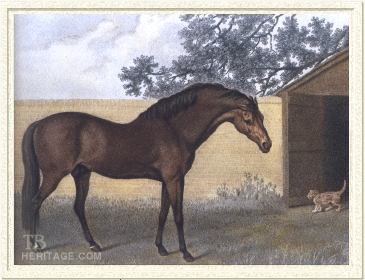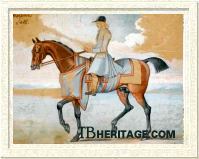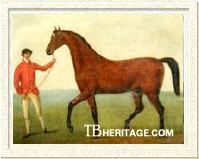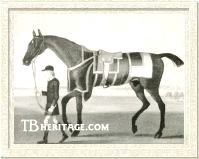|
|
Godolphin Arabian

|
|
 |
|
|
Few horses have as much legend associated with them as does the Godolpin Arabian, but little evidence can corroborate the stories of him being found pulling a water cart in the streets of Paris, or being used as a teaser, or the dramatic stallion battle with Hobgoblin over the lovely, but fickle, mare Roxana.
The facts regarding his origin are few. He was imported from France in 1729 by Mr. Edward Coke, a gentleman with personal connections in France, especially with the Duke of Lorraine. The Duke of Lorraine, later Emperor Francis I of Germany, also figures in the history of the Belgrade Turk. Sir Marmaduke Wyvill, brother-in-law of Edward Coke, purchased the Belgrade Turk from the Duke and brought him to England. It can be presumed that Coke acquired the Godolphin Arabian via the French court, possibly from the Duke himself.
The stallion was probably one of several presented as tribute to the King of France by the Bey of Tunis. While in France he was described by Vicomte de Manty, who said his name was Shami, that he was beautifully-made although "half starved", with a headstrong temperament that made him unloved among the barn staff. It's very likely that he was in poor physical condition following his voyage from Tunis to the court of the French king, but it's unlikely that he ever was reduced to pulling a water cart in Paris.
|

Lath | | Whatever his history, Mr. Coke brought the Arabian to England and stood him at his recently purchased Longford Hall in Derbyshire; in Coke's stud book he is referred to as "ye Arabian." The official story of the Arabian, later known as Lord Godolphin's, begins in 1731, when he covered Mr. Coke's Roxana, (ch.f. 1718) by the Bald Galloway, who was bred by Sir William Strickland. The following spring, Roxana foaled a bay colt by the Arabian, named Lath, who was said to be "a very elegant and beautiful horse," and who was later sold to the Duke of Devonshire.
|
Coke died in August, 1733 at the young age of 32. In his will, he left his small group of mares and foals, including Roxana and Lath, to a personal friend and fellow horseman, Francis, the second Earl of Godolphin, son of the controversial figure, Sidney, the first Earl. His stallions, including the Arabian, Whitefoot, and Hobgoblin, were left to another friend, Roger Williams. In 1733, the Earl acquired the Arabian from Williams, which is how the horse became known as the Godolphin Arabian. He was moved to the Earl's stud near Babraham in the Gog Magog Hills in Cambridgeshire, not far from the racing town of Newmarket. Lord Godolphin's mansion lay within the boundaries of the Iron Age fort known as Wandlebury Ring. The mansion was leveled in 1956, but the stables and other buildings remain on site.
Lath was considered to be the best racehorse of his day, and the best since Flying Childers. He was only a moderately successful stallion for the Duke of Devonshire, and his most influential offspring were generally mares out of daughters of Flying Childers, who also stood at Chatsworth, including Brown Betty, Gipsy, and several mares named on a theme: Crazy, Ancaster Crazy, Devonshire Crazy, and a sister to Crazy.
|

Regulus

Cade

Blank | | Lath was outstanding, but the Godolphin Arabian sired an even better one in Lord Chedworth's Regulus (b.c. 1739) out of Grey Robinson by Bald Galloway, who was undefeated in his racing career, including seven King's Plates won as a six-year-old. Regulus was an important sire, his progeny included Fearnought, sent to America and one of the earliest leading sires of runners in the colonies. Other sons included South, Prophet, Brutus, Chesnut Ranger, and Jalap (considered a foundation sire of the Cleveland Bay breed). Without a doubt, Regulus' most important daughter was Spiletta, dam of Eclipse.
The most important son of the Godolphin Arabian in the grand scheme of things, however, was Cade (b.c. 1734), a full brother to Lath. The General Stud Book notes that Cade's dam, Roxana, "died in 1734, within a fortnight after foaling; the produce was reared with cow's milk." Cade was much inferior to Lath as a runner, but vastly superior as a sire, and it is through Cade that the male line continues down to the present time, through Cade's great son Matchem. Cade also sired the important American stallion imported Wildair, besides Bandy, Changeling, Young Cade, Warren's Sportsman, Silvio, Northumberland, and many important broodmares including Kitty Fisher, Naylor, Miss Meredith, and several unnamed daughters.
Another extremely influential son of the Godolphin Arabian was Blank (b.c. 1740), out of the Little Hartley Mare by Bartlett's Childers. Blank sired Chrysolite, Pacolet, Centinel, Paymaster, Tatler, Fallower, and counted among his daughters the dam of the great runner and sire Highflyer, and the Duke of Granfton's mare Julia. Blank had a full brother named Janus (b.c. 1738), noted as the sire of imported (Old) Janus, who was a tremendous sire of quarter mile runners in colonial America. |
Other important sons of the Godolphin Arabian include Babraham (undefeated), Dismal (undefeated), Dormouse (undefeated), Bajazet, Old England, Mogul, the Coalition Colt, the Gower Stallion, the Godolphin Colt, Whitenose, Brother to Whitenose, Cripple (sire of Gimcrack), Feather, Matchless, Dimple, Cygnet, Omar, and Lofty.
Several daughters of the Godolphin Arabian proved influential, but none so much as imported Selima (b.f. 1746), out of a mare by the notorious Hobgoblin. Selima was a foundation mare in America for the famous stud of Governor Ogle at Belair in Maryland. Another daughter was the famous "sister to Regulus" (b.f. 1743) who is the main conduit for the #11 family. In all, the Godolphin Arabian is credited with siring about 90 foals, but his influence, immediate and long range, was staggering.
On occasion, the Godolphin may have been referred to as a "Barb", because of his believed country of origin, Tunisia, on the Barbary Coast. Descriptions of him and portraits seem to indicate he was a horse of exquisite quality, more likely an Arabian. There are few physical observations of the horse from life, and one of the best is given by the veterinary surgeon Osmer, as quoted by Prior. "There never was a horse (at least, that I have seen) so well entitled to get racers as the Godolphin Arabian; for, whoever has seen this horse must remember that his shoulders were deeper, and lay farther into his back, than those of any horse ever yet seen. Behind the shoulders, there was but a very small space ere the muscles of his loins rose exceedingly high, broad, and expanded, which were inserted into his hindquarters with greater strength and power than in any horse I believe ever yet seen of his dimensions, viz fifteen hands high."
Another description, by Vicomte de Manty, is quoted in Mourdant Milner's book "The Godolphin Arabian". "He was of beautiful conformation, exquisitely proportioned with large hocks, well let down, with legs of iron, with unequalled lightness of forehand - a horse of incomparable beauty whose only flaw was being headstrong. An essentially strong stallion type, his quarters broad in spite of beign half starved, tail carried in true Arabian style."
He had a small head on a well arched and crested neck, was short-backed with tremendous quarters and a high-set tail. He had great bone, action, and a fiery temperament. He was described as a brown bay ("with reddish mottle"), about 15 hands high (one source says 14.2h.) with some white on the off hind heel. He was said to be small, but that his get usually stood taller. His constant companion was the cat, Grimalkin.
The Godolphin Arabian died in 1753 at an advanced age estimated to be 29 years (presuming he was a mature stallion of five or six upon his arrival in England). A solemn ceremony was performed at gravesited and he was laid to rest under a gateway at the stable. A stone slab was placed over his grave with an inscription noting who lay underneath. This gravesite is still in existence inside the archway of the stable block within the building complex inside Wandlebury Ring.
--Anne Peters
|
|
|
|

